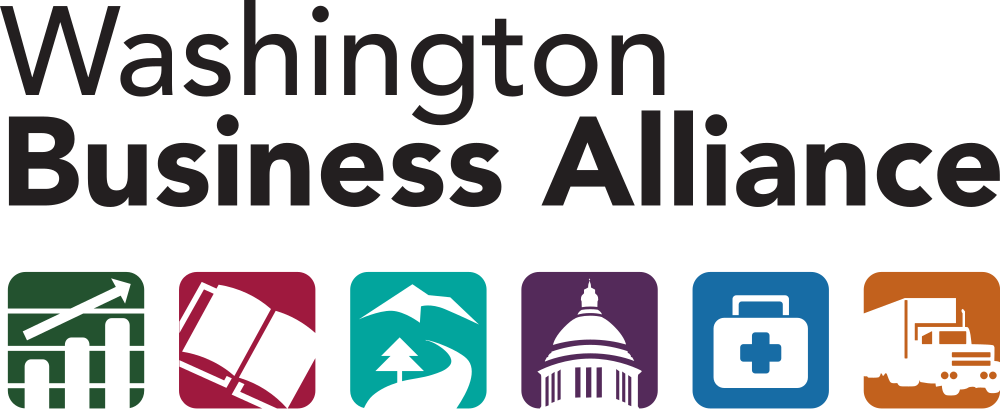A panel of experts, convened by the Washington Business Alliance, weighed in before an audience of business leaders regarding the state’s positioning within the national innovation ecosystem. Each respondent was asked to identify Washington’s greatest strengths and weaknesses as a competitor in the global innovation race.
Fred Holt, Head of Strategic Initiatives, University of Washington,Center for Commercialization:
- Washington State’s greatest strength is “the density of activity, the willingness for people to jump in and help in supporting an ecosystem. It’s sort of like a potluck. If you’re going to a potluck and all you show up with is your plate and fork… it’s not the same as if you make your best dish and dive in. It’s very transformative that way.
- One of the weaknesses I see for Washington… is doing this connectivity at a greater scale.”
- Former Sen. Jim Kastama
Jim Kastama, Former State Senator & Chairman of the Senate Economic Development, Trade & Innovation Committee:
- “Our ability to attract key entrepreneurs and talent in this area has been obviously one of our strengths. I think part of that attraction has been this sense of balance that people think they can achieve in Washington State… between lifestyle and intellectual fire power. When it comes to the intellectual fire power, I think we always think of things like Microsoft, Boeing, Amazon, et cetera — But I would say that the origins of all of that actually come down to institutions like the University of Washington with its research and defense and life sciences, and then WSU with its work on energy.
- Now, as far as the negatives, I think a real negative probably was summed up by [‘father of the internet’] Vint Cerf. In a conversation I had with him, he said [Washington’s] economic success seems to be somewhat accidental.” And I would tend to agree with that… During the recession we actually made drastic cuts to the higher education… We made cuts to cluster creation strategy funds, commercialization, even the R&D tax credit was eliminated. Our decisions seemed to be more politically based, as opposed to more long-term, strategically and economically based. In 1989 when Finland suffered a severe cutback in its revenue, due to the fall of the Soviet Union… they doubled down on commercialization, they doubled down on R&D and entrepreneurial programs, and they actually cut a lot of their social safety net programs; quite a bit different than our approach. But their point was that we can’t have those social service programs, we can’t have the safety net if we don’t have a robust economy to create jobs and that income.”
- Randy Gardiner
Randy Gardiner, CEO, Red Dot:
- “I think one of the greatest strengths in this region is the number of high-tech industry and high-tech manufacturing businesses that are here. The other piece that we have is we have a great angel network that is out there willing and able to evaluate the marketability and commercialization of great ideas. If you didn’t have that, some of these great innovations that are made would likely never get to market.
- Washington’s weaknesses is the connection between industry and our educational institutions… It’s as if we were training athletes, not by performance in a game, but by conditioning. We condition and condition and condition… and then we say, “Okay, go out and play a game.” They’ve never had any experience playing the game. We’ve got to get industry and the educational institutions working together so the great ideas that are created in the institutions actually can be commercialized and create jobs and bring those jobs to fruition. That’s one of the greatest weaknesses.”
Anson Fatland, Vice President for Economic Development and External Affairs, Washington State University:
- “I think people are our greatest strength and I think they’re also probably one of our strongest weaknesses, if that makes any sense. I lived in San Francisco for a number of years, and there is a dramatic disparity between the level of cooperation and partnership that I see here in the Northwest, and what I saw in the Bay area. So you would come to [an event], people would be collegial, they would be sort of interactive, but you knew they were really trying to figure out how they could get above you, how they could get around you, and how they could use you to advance their own agenda. You don’t have that sense here.
- I would also tell you one of the greatest weaknesses is the lack of skilled labor in this region. I was talking with [redDOT CEO] Randy [Gardiner] at breakfast and he can’t fill the spots in his company fast enough. This is not something that’s unique to the manufacturing industry.” Fatland also criticized the state’s failure to invest in building human capital. “In higher education… all of our higher education institutions have been asked to model a 15 percent cut to our budgets. That’s strangling. That is dismantling brick by brick one of the strongest producers of innovators that this region will have.”
- Dr. Margaret McCormick
Margaret McCormick, CEO, Matrix Genetics:
- “Speaking for the life science industry, I think that what Washington is great at is that front end of innovation: coming up with ideas, being creative, and getting those patents. Think about all of the amazing gains and activities that Washington State has generated, from ultrasound to Enbrel. It’s just incredible.
- What we’re really bad at is the execution… When execution succeeds, keeping the company here is another challenge. For instance, Amgen which bought a company here a few years ago and now we’re losing it. It’s going to be a huge blow to the area. I think if we can articulate a compelling value proposition for companies to stay here once they innovate here, that would be great.”
